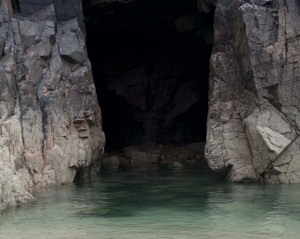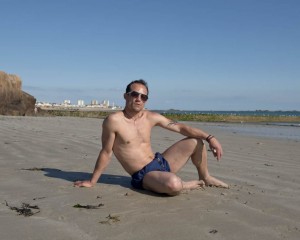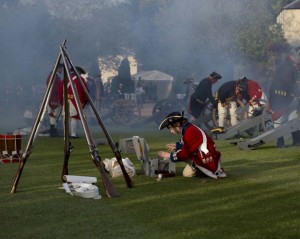For this particular part of the coursework we are looking at the three words ‘chance, change and challenge’. To me this is exactly what performance photography embodies. In order to make a great photograph/film you need to take a chance and try to anticipate what your audience are going to think. You also need to change your perspective of photography and not do what is expected, something that isn’t conventional to photography. You don’t need to concentrate too much on the composition of the photograph just as long as your subject is in frame. Finally performance photography is a challenge as it challenges the way I think and how I plan a photo shoot. This style of photography is all down to chance and how you as an individual photographer can create something great just on the spot in the environment you are surrounded by. I am excited to see how this project turns out as it does challenge the way I think about photography. Your work can either be really great or something that only the spectators who were there are able to see.
Daily Archives: June 15, 2015
Filters
Tom Pope 2015 Photographer in Residence
Tom Pope is a British photographer born in 1986. He lives and works in London. Pope is the 2015 Photographer in Residence at the Jersey Photo Archives. Last Tuesday we worked with Pope alongside the Jersey Archisle where we did a few workshops to develop our understanding of Performance Photography. Pope is a performance photographer who usually goes on impulse and finds objects when he goes to where he is going to perform.
Pope’s performances are all recorded where he will find an image within each film. Often Pope’s spectators are those who happen to be on the scene at the time as he doesn’t pre-plan or tell anyone where he is going to be in a place.
So It Goes Project:
http://www.tompope.co.uk/soitgoes.html
So It Goes project interview:
The So It Goes project is filled with many different concepts that Pope has managed to create and are displayed on his blog which is linked above. The story of the Grandfather clock has a deeper meaning of living a life without time, which explains destroying the clock and carrying it around in a hearse. I like the idea of this project as in many ways people of our generation would be lost without time. They wouldn’t be able to do the usual things that we are expected to do, such as getting to work and school on time. What if time didn’t exist? What if we didn’t have to live in a world were time was the most important aspect and that we wouldn’t have to worry constantly about not having enough of it.
Another great project of Pope’s is the Fountain Bike. Here Pope made a bike with a mannequin hand holding up a hose pipe which was filtered from the rain water at the side of a road in the UK. Here Pope simply cycled on the spot in the rain and whoever was walking past was his audience and spectators.
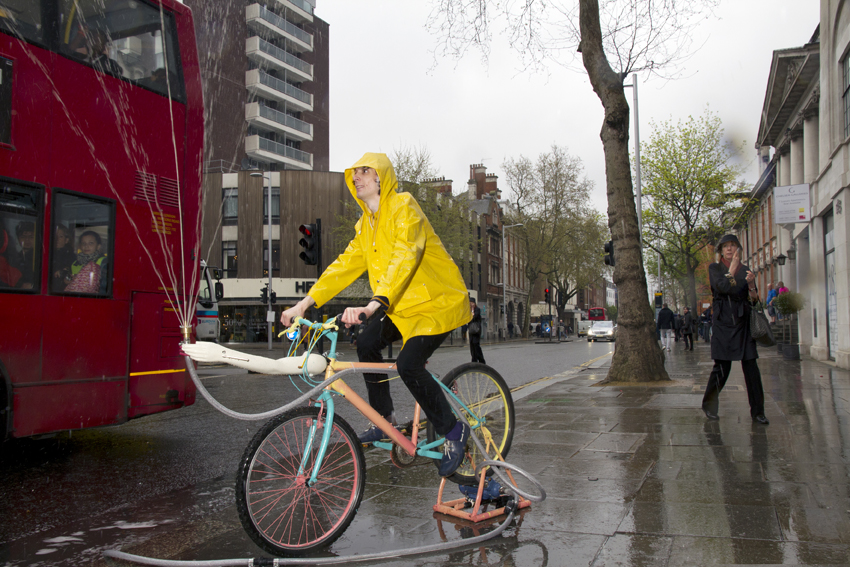 I like the vibrant colour of his yellow rain coat and the bright colours on the bike which make it stand out, as well as the obvious that water is shooting off the front of the bike through a hose pipe which is being held up by a mannequin hand and the water being produced from the rain water on the side of a road. This film still show many spectators of Pope’s performance. The first is the woman walking past on the street, moving to the side to avoid getting more wet from the water coming off the bike. The other spectators are the children on the bus who are looks at Pope in an entertained/confused way. I like that Pope will just go out and create something completely random to make an impact and to perform for the people who happen to be there at that time.
I like the vibrant colour of his yellow rain coat and the bright colours on the bike which make it stand out, as well as the obvious that water is shooting off the front of the bike through a hose pipe which is being held up by a mannequin hand and the water being produced from the rain water on the side of a road. This film still show many spectators of Pope’s performance. The first is the woman walking past on the street, moving to the side to avoid getting more wet from the water coming off the bike. The other spectators are the children on the bus who are looks at Pope in an entertained/confused way. I like that Pope will just go out and create something completely random to make an impact and to perform for the people who happen to be there at that time.
On Wednesday 17th the photography group are going to St Malo for the day along with Tom Pope and the Archisle people to show our skills in the art of performance photography. I am excited to see how this turns out and if we manage to come up with visually interesting pieces.
Yury Toroptsov 2014 Photographer in Residence
Yury Toroptsov was the photographer in residence at the Jersey Photo Archives in 2014. He was born in 1974 in Vladivostok, in Russia. Toroptsov is a photographer who focuses on the common denominator for distant cultures. He looks at people and their identity and the permanence of myths. Memories, metamorphosis, profane and sacred are the recurring themes in his photographs. He currently lives and works in Paris.
During Toroptsov’s six month period in working in Jersey, he found some old videos from the Second World War of the Battle of Flowers which still went on even throughout the duration of the war.
http://www.toroptsov.com/en/projects/fairyland.htm
Toroptsov was influenced by a particular float called ‘Fairyland’ which is developed in the first video on his website of the Fairyland page. This interests me as he looks deeper into Jersey and uses the Archive as a way to access the present day. This backs up what the Archisle man stated that ‘you need to understand a history to anticipate the future’. We as a community need to reflect and understand the past to move forward.
One photo in particular which I like is the one of a bench with a plague on it that says ‘In Appreciation Of Being Jersey Born – K.J.H.’. The reason I really like this image is because of the simple message that we should be proud to be Jersey born. Often people tell me that they wish they weren’t from here or that they don’t consider themselves as from here but instead from the background of where their parents are from. I am proud and happy to have been born and live in such a beautiful island. Although the island has many setbacks and is very cushioned compared to the rest of the world, I think that it has so much to offer. In the beauty of its landscapes and all the different cultures we have on the island. I like this image because it is simple yet powerful.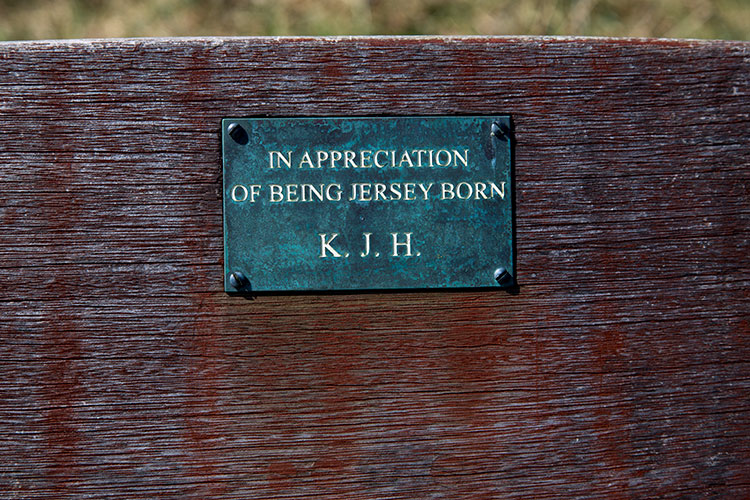
Michelle Sank 2013 Photographer in Residence
http://www.michellesank.com
Michelle Sank is a South African photographer who moved to England in 1987. Sank is a social documentary photographer, with her work illuminating issues around social and cultural diversity. Sank was in Jersey for six months working on a project called ‘Insula’.
These set of images follow the Archives of the past with photographers such as Henry Mullins who recorded his photographs in rows of four in large photo albums. This set of images shows the people of today living in Jersey and how different cultures and social classes live rather than just the higher social classes which were recorded in the past. I like these images as they can show the different personalities of the people of Jersey as well as letting the spectator in on the environment surrounding the subject.
One image which I find really interesting is the one below of Liberation Square on Liberation Day 2013. It interests me because of the Union Jack in the background because I would have actually expected to see the Jersey flag and not the British. One reason being that the Prime Mister at the time of World War II, Churchill, chose not to defend Jersey against Nazi invasion and also failed to announce that the Channel Islands were unarmed resulting in 47 innocent Jersey farmers to be shot and killed when the Germans arrived. Although, I realise that the reason the Channel Islands were liberated the day after Britain was because of the great effort the British and the Americans put into defending the rest of the world against the German Nazis.
I like this image because it shows how the people of Jersey will come together on this one day, 9th May, to celebrate the freedom and liberation of its past people and its ancestors.

Societe Jersiase Photo Archive 2015
On Tuesday 9th June 2015 all the year 12 photography students were invited down to the Societe Jersiaise Archives to learn more about the photo archive we have on the island and as an introduction to the 2015 Resident Photographer Tom Pope.
Throughout this workshop we were put into groups to work with. At first we watched a presentation made my one of the people who work at the Archisle Jersey. In his presentation he taught us that photography is a tool for questioning what art is and what it can be. This can be developed in art history and the sciences.
http://societe-jersiaise.org/photographic-archive
Photography is used for many things, such as; advertising/criminal/passport/travel/family/marketing etc.
The archives can tell a story about you, for example the photos you take and choose to save. The photos that you keep can tell a lot about your personality and what interests you. I like to print out my photographs so that I have a physical copy of them to look at as memories as I grow. I also have a huge archive of photographs on my old laptop and my new laptop. This is where I store the bulk load of photos that I have accumulated over my life and am still gaining more and more each day. I prefer to have physical copies of my favourite photographs so that I can access them and look at them without having to search through my laptops for a load of photos from years ago. I think this is because my family have so many photo albums filled with memories and good times. I like the idea of using photo archives as a way to reconnect with my past and to show how much I have changed and developed to the present day.
A man called Henry Mullins [1848-1873] had the first ever photography studio in Jersey! He was very successful as most people in Jersey came to him for their photographs to be taken. He took photos of the most wealthy who lived on the island, which has now become a large archive for the Jersey people of today. Mullins would put all of his images in rows of four with the persons title below so that he would know who was who which has proved very helpful today as we are able to look at these photo albums and see who was around this island many years ago.
The man from the Jersey Archives also said that the Archives can show how portraits have changed and developed over the centuries. This allows us to see who was around in Jersey in the past. It also shows the difference in social classes from the past and now. It shows how the only people who were ever photographed in the past were of a higher social class whereas nowadays pretty much anyone is able to take photographs.
– photography is always contradicting itself
– Michelle Sank is one of the photographers in resident in Jersey a few years ago [2013].
http://www.michellesank.com
– Yury Toroptsov was the photographer in resident in Jersey last year and was very much influenced by the Battle of Flowers as part of his 6 month project in Jersey [2014].
http://www.toroptsov.com
In photography we need to learn to look beyond just what we can physically see in front of us and instead look at the connotation of an image or set of images. We need to understand what the subject can make you feel and how it influences you as an individual. We as photographers need to anticipate what our audiences’ are going to think and feel about our work.
Chance, Change and Challenge
‘Chance, Change and challenge’ is the title of our 6 week project, this title is closely linked with the work we will be doing with the archive at the Societe Jersiaise and the photographer in residence Tom Pope. Chance is the possibility of something happening. Change is to make or become something different and challenge is to dispute the truth or validity of something. I think that this title will allow us to explore, think deeper into the subject and learn about the history as well as engage with the community that we live in. The photographs and videos that we will be taking will have a deeper meaning and context behind them rather than just taking a photograph because it’s appealing to the eye. I think that this project will be interesting because it’s almost as if we are ‘discovering’ new things and changing the way at which we look at photography.
Tom Pope
On Tuesday we had a workshop with a photographer called Tom Pope. He was accepted at the Swansea Metropolitan University where he got a 1st Class Ba(Hons) for Photography of the Arts in 2008, and then got a Ma at The Royal College of Arts in 2011.
He has his own website where you can view all his work. We had had a look at a few of his videos and photos in class on Monday but I personally didn’t quite understand all of his work. He showed us a fair amount of his work within his presentation and it was then, when he was explaining the process and reasoning behind his work that I started to understand what he was trying to achieve through his work.
One of these photo shoots which I now really like is titled Weak Anarchy. His intentions behind this set was looking at social norms and unofficial ‘rules’ society has see mingly put in place, and seeing how far you can push them, going from simply wearing socks on the wrong feet, to making a fountain in a public space with a lemonade bottle and mentos. Pushing societies rules is a fairly common theme among his work.
mingly put in place, and seeing how far you can push them, going from simply wearing socks on the wrong feet, to making a fountain in a public space with a lemonade bottle and mentos. Pushing societies rules is a fairly common theme among his work.
He mentioned a lot of things which he tries to incorporate in his work, like Time, Play, Situationism, Humour, Repetition, Psycho-geography, differences between public and private, Failure, collaboration and more.



















